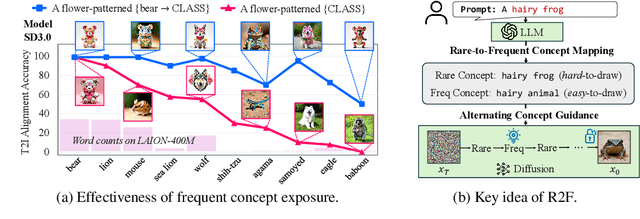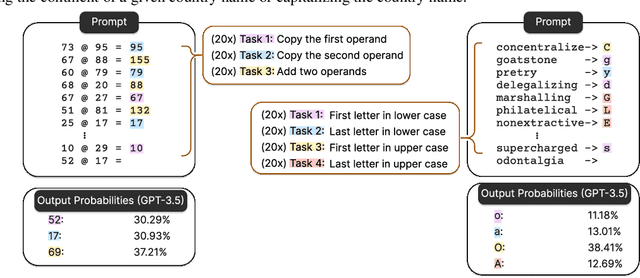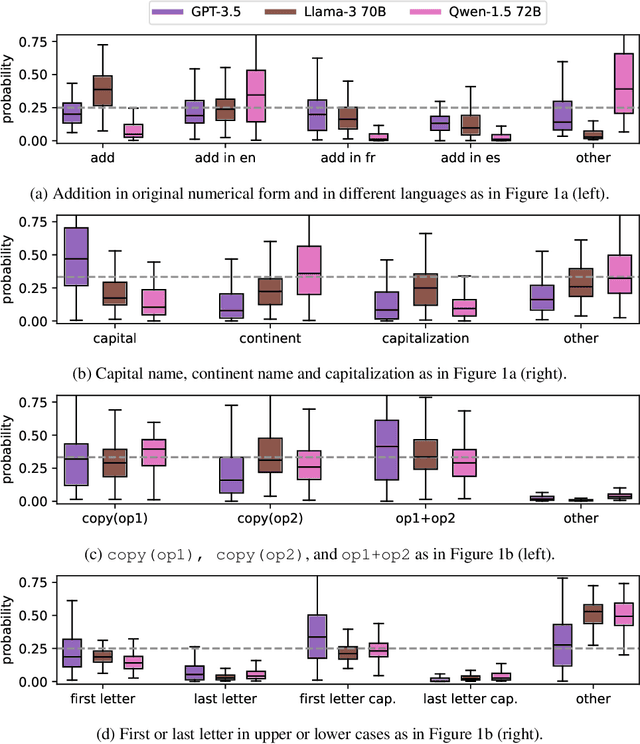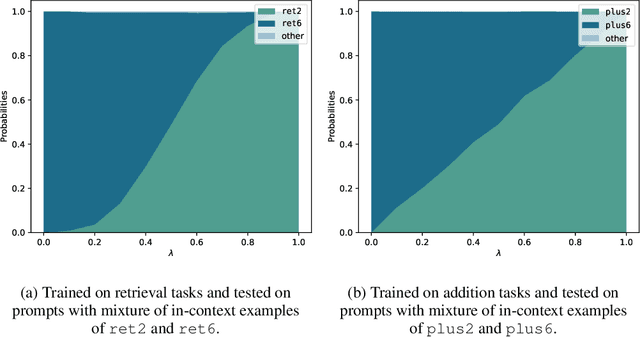Kangwook Lee
ParallelBench: Understanding the Trade-offs of Parallel Decoding in Diffusion LLMs
Oct 06, 2025Abstract:While most autoregressive LLMs are constrained to one-by-one decoding, diffusion LLMs (dLLMs) have attracted growing interest for their potential to dramatically accelerate inference through parallel decoding. Despite this promise, the conditional independence assumption in dLLMs causes parallel decoding to ignore token dependencies, inevitably degrading generation quality when these dependencies are strong. However, existing works largely overlook these inherent challenges, and evaluations on standard benchmarks (e.g., math and coding) are not sufficient to capture the quality degradation caused by parallel decoding. To address this gap, we first provide an information-theoretic analysis of parallel decoding. We then conduct case studies on analytically tractable synthetic list operations from both data distribution and decoding strategy perspectives, offering quantitative insights that highlight the fundamental limitations of parallel decoding. Building on these insights, we propose ParallelBench, the first benchmark specifically designed for dLLMs, featuring realistic tasks that are trivial for humans and autoregressive LLMs yet exceptionally challenging for dLLMs under parallel decoding. Using ParallelBench, we systematically analyze both dLLMs and autoregressive LLMs, revealing that: (i) dLLMs under parallel decoding can suffer dramatic quality degradation in real-world scenarios, and (ii) current parallel decoding strategies struggle to adapt their degree of parallelism based on task difficulty, thus failing to achieve meaningful speedup without compromising quality. Our findings underscore the pressing need for innovative decoding methods that can overcome the current speed-quality trade-off. We release our benchmark to help accelerate the development of truly efficient dLLMs.
Draft-based Approximate Inference for LLMs
Jun 10, 2025Abstract:Optimizing inference for long-context Large Language Models (LLMs) is increasingly important due to the quadratic compute and linear memory complexity of Transformers. Existing approximation methods, such as key-value (KV) cache dropping, sparse attention, and prompt compression, typically rely on rough predictions of token or KV pair importance. We propose a novel framework for approximate LLM inference that leverages small draft models to more accurately predict the importance of tokens and KV pairs. Specifically, we introduce two instantiations of our proposed framework: (i) SpecKV, which leverages a draft output to accurately assess the importance of each KV pair for more effective KV cache dropping, and (ii) SpecPC, which uses the draft model's attention activations to identify and discard unimportant prompt tokens. To the best of our knowledge, this is the first work to use draft models for approximate LLM inference acceleration, extending their utility beyond traditional lossless speculative decoding. We motivate our methods with theoretical and empirical analyses, and show a strong correlation between the attention patterns of draft and target models. Extensive experiments on long-context benchmarks show that our methods consistently achieve higher accuracy than existing baselines, while preserving the same improvements in memory usage, latency, and throughput. Our code is available at https://github.com/furiosa-ai/draft-based-approx-llm.
In-Context Learning with Hypothesis-Class Guidance
Feb 28, 2025



Abstract:Recent research has investigated the underlying mechanisms of in-context learning (ICL) both theoretically and empirically, often using data generated from simple function classes. However, the existing work often focuses on the sequence consisting solely of labeled examples, while in practice, labeled examples are typically accompanied by an instruction, providing some side information about the task. In this work, we propose ICL with hypothesis-class guidance (ICL-HCG), a novel synthetic data model for ICL where the input context consists of the literal description of a (finite) hypothesis class H and $(x,y)$ pairs from a hypothesis chosen from H. Under our framework ICL-HCG, we conduct extensive experiments to explore: (i) a variety of generalization abilities to new hypothesis classes; (ii) different model architectures; (iii) sample complexity; (iv) in-context data imbalance; (v) the role of instruction; and (vi) the effect of pretraining hypothesis diversity. As a result, we show that (a) Transformers can successfully learn ICL-HCG and generalize to unseen hypotheses and unseen hypothesis classes, and (b) compared with ICL without instruction, ICL-HCG achieves significantly higher accuracy, demonstrating the role of instructions.
VersaPRM: Multi-Domain Process Reward Model via Synthetic Reasoning Data
Feb 10, 2025



Abstract:Process Reward Models (PRMs) have proven effective at enhancing mathematical reasoning for Large Language Models (LLMs) by leveraging increased inference-time computation. However, they are predominantly trained on mathematical data and their generalizability to non-mathematical domains has not been rigorously studied. In response, this work first shows that current PRMs have poor performance in other domains. To address this limitation, we introduce VersaPRM, a multi-domain PRM trained on synthetic reasoning data generated using our novel data generation and annotation method. VersaPRM achieves consistent performance gains across diverse domains. For instance, in the MMLU-Pro category of Law, VersaPRM via weighted majority voting, achieves a 7.9% performance gain over the majority voting baseline -- surpassing Qwen2.5-Math-PRM's gain of 1.3%. We further contribute to the community by open-sourcing all data, code and models for VersaPRM.
Self-Improving Transformers Overcome Easy-to-Hard and Length Generalization Challenges
Feb 03, 2025Abstract:Large language models often struggle with length generalization and solving complex problem instances beyond their training distribution. We present a self-improvement approach where models iteratively generate and learn from their own solutions, progressively tackling harder problems while maintaining a standard transformer architecture. Across diverse tasks including arithmetic, string manipulation, and maze solving, self-improving enables models to solve problems far beyond their initial training distribution-for instance, generalizing from 10-digit to 100-digit addition without apparent saturation. We observe that in some cases filtering for correct self-generated examples leads to exponential improvements in out-of-distribution performance across training rounds. Additionally, starting from pretrained models significantly accelerates this self-improvement process for several tasks. Our results demonstrate how controlled weak-to-strong curricula can systematically teach a model logical extrapolation without any changes to the positional embeddings, or the model architecture.
Task Vectors in In-Context Learning: Emergence, Formation, and Benefit
Jan 16, 2025Abstract:In-context learning is a remarkable capability of transformers, referring to their ability to adapt to specific tasks based on a short history or context. Previous research has found that task-specific information is locally encoded within models, though their emergence and functionality remain unclear due to opaque pre-training processes. In this work, we investigate the formation of task vectors in a controlled setting, using models trained from scratch on synthetic datasets. Our findings confirm that task vectors naturally emerge under certain conditions, but the tasks may be relatively weakly and/or non-locally encoded within the model. To promote strong task vectors encoded at a prescribed location within the model, we propose an auxiliary training mechanism based on a task vector prompting loss (TVP-loss). This method eliminates the need to search for task-correlated encodings within the trained model and demonstrably improves robustness and generalization.
Multi-Bin Batching for Increasing LLM Inference Throughput
Dec 03, 2024



Abstract:As large language models (LLMs) grow in popularity for their diverse capabilities, improving the efficiency of their inference systems has become increasingly critical. Batching LLM requests is a critical step in scheduling the inference jobs on servers (e.g. GPUs), enabling the system to maximize throughput by allowing multiple requests to be processed in parallel. However, requests often have varying generation lengths, causing resource underutilization, as hardware must wait for the longest-running request in the batch to complete before moving to the next batch. We formalize this problem from a queueing-theoretic perspective, and aim to design a control policy which is throughput-optimal. We propose Multi-Bin Batching, a simple yet effective method that can provably improve LLM inference throughput by grouping requests with similar (predicted) execution times into predetermined bins. Through a combination of theoretical analysis and experiments, including real-world LLM inference scenarios, we demonstrate significant throughput gains compared to standard batching approaches.
Rare-to-Frequent: Unlocking Compositional Generation Power of Diffusion Models on Rare Concepts with LLM Guidance
Oct 29, 2024



Abstract:State-of-the-art text-to-image (T2I) diffusion models often struggle to generate rare compositions of concepts, e.g., objects with unusual attributes. In this paper, we show that the compositional generation power of diffusion models on such rare concepts can be significantly enhanced by the Large Language Model (LLM) guidance. We start with empirical and theoretical analysis, demonstrating that exposing frequent concepts relevant to the target rare concepts during the diffusion sampling process yields more accurate concept composition. Based on this, we propose a training-free approach, R2F, that plans and executes the overall rare-to-frequent concept guidance throughout the diffusion inference by leveraging the abundant semantic knowledge in LLMs. Our framework is flexible across any pre-trained diffusion models and LLMs, and can be seamlessly integrated with the region-guided diffusion approaches. Extensive experiments on three datasets, including our newly proposed benchmark, RareBench, containing various prompts with rare compositions of concepts, R2F significantly surpasses existing models including SD3.0 and FLUX by up to 28.1%p in T2I alignment. Code is available at https://github.com/krafton-ai/Rare2Frequent.
Parameter-Efficient Fine-Tuning of State Space Models
Oct 11, 2024Abstract:Deep State Space Models (SSMs), such as Mamba (Gu & Dao, 2024), have emerged as powerful tools for language modeling, offering high performance with efficient inference and linear scaling in sequence length. However, the application of parameter-efficient fine-tuning (PEFT) methods to SSM-based models remains largely unexplored. This paper aims to systematically study two key questions: (i) How do existing PEFT methods perform on SSM-based models? (ii) Which modules are most effective for fine-tuning? We conduct an empirical benchmark of four basic PEFT methods on SSM-based models. Our findings reveal that prompt-based methods (e.g., prefix-tuning) are no longer effective, an empirical result further supported by theoretical analysis. In contrast, LoRA remains effective for SSM-based models. We further investigate the optimal application of LoRA within these models, demonstrating both theoretically and experimentally that applying LoRA to linear projection matrices without modifying SSM modules yields the best results, as LoRA is not effective at tuning SSM modules. To further improve performance, we introduce LoRA with Selective Dimension tuning (SDLoRA), which selectively updates certain channels and states on SSM modules while applying LoRA to linear projection matrices. Extensive experimental results show that this approach outperforms standard LoRA.
Everything Everywhere All at Once: LLMs can In-Context Learn Multiple Tasks in Superposition
Oct 08, 2024



Abstract:Large Language Models (LLMs) have demonstrated remarkable in-context learning (ICL) capabilities. In this study, we explore a surprising phenomenon related to ICL: LLMs can perform multiple, computationally distinct ICL tasks simultaneously, during a single inference call, a capability we term "task superposition". We provide empirical evidence of this phenomenon across various LLM families and scales and show that this phenomenon emerges even if we train the model to in-context learn one task at a time. We offer theoretical explanations that this capability is well within the expressive power of transformers. We also explore how LLMs internally compose task vectors during superposition. Furthermore, we show that larger models can solve more ICL tasks in parallel, and better calibrate their output distribution. Our findings offer insights into the latent capabilities of LLMs, further substantiate the perspective of "LLMs as superposition of simulators", and raise questions about the mechanisms enabling simultaneous task execution.
 Add to Chrome
Add to Chrome Add to Firefox
Add to Firefox Add to Edge
Add to Edge